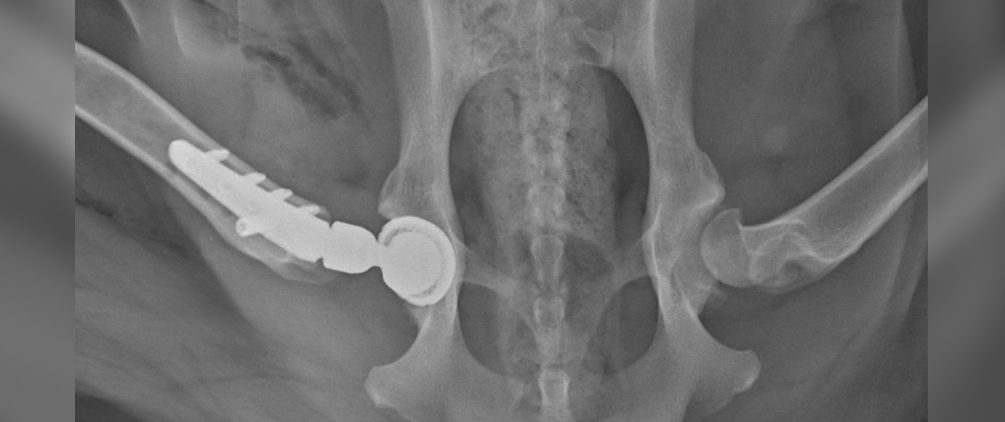Hip Dysplasia in Dogs
Fixed prices. Fixed pets. 
What is hip dysplasia in dogs?
Dysplasia is the abnormal growth or development of a tissue, bone or organ. Hip dysplasia is an inherited, developmental condition of the hip joint.
Affected animals are born with normal hips but have a genetic predisposition to dysplasia and as they grow incongruity (misfit) develops in the affected joints. This is manifested as laxity, or looseness, in the joint and then later in life secondary osteoarthritis occurs.
Usually, both hip joints are affected but the severity can vary between them.


What are the signs of hip dysplasia?
Signs of hip dysplasia are usually seen in two stages. The first is during the development or growth phase when dogs are six to eighteen months old. At this age, the signs are due to the laxity. The second phase is seen in skeletally mature dogs, and the signs are a result of osteoarthritis.
Young dogs:
• Hindlimb lameness
• Swaying hindlimb
• Weak hindlimbs
• Bunny hopping when running
• Inability to jump
• Reluctance to exercise
Adult dogs:
• Hindlimb lameness
• Hindlimb stiffness
• Inability to jump
• Reluctance to exercise
What dog breeds are prone to hip dysplasia?
Hip dysplasia can affect any breed of dog but Labradors, Golden Retrievers, German Shepherd dogs and Border Collies are more commonly seen.
How is it diagnosed?
The diagnosis of hip dysplasia is based on the history, clinical signs and imaging. The findings will be different depending on which phase the dog is in.
Clinical examination
In young dogs there is usually pain on extension of the hips. In some cases laxity can be felt in the joint and there are specific tests to assess for this, one of which is called the Ortolani test. There may be muscle loss over the hips and hindquarters. For full assessment of laxity, examination under sedation or anaesthesia is usually required.
In adult dogs there is often a reduction in hip extension and there can be discomfort when this is attempted. There may be crepitus (roughness or grating) to the joint when it is manipulated. Muscle loss may also be present.
Radiography
In young dogs the main feature on radiography is subluxation of the hip joint. This is assessed by how well the femoral head (the ball) is seated within the socket. If there is joint laxity the femoral head will not be covered adequately by the socket.
In older dogs the main radiographic feature is osteoarthritic change in the hip joints. This is shown by new bone formation around the joint and remodelling of the ball and socket components of the joint.
How do you treat hip dysplasia?
The treatment of hip dysplasia will depend on the severity of clinical signs. Many animals will have minimal or even no clinical signs. It is also important to remember that the severity of radiographic signs does not correlate with the severity of clinical signs.
In animals that are showing signs there are a range of medical and surgical treatments available to manage these. The choice of treatment will depend on the individual case and the options will always be discussed with you prior to treatment.
Conservative Management
This consists of exercise management, weight control, physiotherapy and hydrotherapy.
Joint supplements, anti-inflammatories and analgesics (pain killers) are often combined with these.
This approach is effective for mild cases and should always be considered the first line approach, even in cases with more advanced signs.
Double or Triple Pelvic Osteotomy
Double or triple pelvic osteotomy (D/TPO) is a surgery which involves cutting the pelvis and rotating it to give more coverage over the femoral head (the ball).
The pelvis is fixed in its new position with a metal plate and screws. This surgery is usually carried out in young dogs under ten months before any osteoarthritis has developed.
Femoral Head and Neck Ostectomy
Femoral head and neck ostectomy (FHNO) is a surgery where the ball and neck region of the femur are cut off and removed.
The dog will then form a false joint between the end of the femur and the pelvis. There can be less successful compared to other procedures in terms of hip function, often due to a reduced range of movement.
However, the aim of the surgery is to reduce the pain from the diseased hip and this is normally achieved. Dogs that undergo this procedure will benefit from physiotherapy and hydrotherapy as part of their rehabilitation.
Total Hip Replacement
Total hip replacement (THR) is the best surgery for achieving both pain relief and a good functional outcome.
The surgery involves removing the ball of the femur and replacing it with a metal ball attached to a stem inserted into the femur. The socket is reamed (deepened) to remove the diseased joint and an artificial cup (socket) is inserted.
The two components are then reduced (fitted) together to form the artificial joint.
There are both cemented and non-cemented hip replacement systems available. THR can be carried out from about ten months of age.
At Southpaw, we use the Kyon non-cemented system.
Frequently Asked Questions
What are the causes of hip dysplasia?
Hip dysplasia is an inherited developmental condition but other factors influence how this is expressed. These include growth rate, exercise, and nutrition.
How long can a dog live with hip dysplasia?
A dog can have hip dysplasia and live a normal life, with many animals showing no or minimal clinical signs.
However, dogs which do show signs can have a good quality of life with either conservative management or, in more severe cases, surgical treatments.
Can you fix hip dysplasia in dogs?
Hip dysplasia can not be fixed but it can be managed and in the majority of cases this is medical management. In more severely affected cases, surgery is an option.
Femoral head and neck ostectomy (FHNO) and total hip replacement (THR) are salvage procedures where the diseased joint is removed. In THR, these structures are replaced with artificial components.
What age does hip dysplasia start in dogs?
Dogs with hip dysplasia are born with a genetic predisposition to hip laxity and as they grow this develops in the hip joints.
How can I treat my dog’s hip dysplasia at home?
Exercise management and weight control are very important components to helping dogs with hip dysplasia.
Environmental modifications like ramps for getting in and out of vehicles and soft bedding can also be beneficial.
How long does it take for a dog to recover from hip dysplasia?
A dog with hip dysplasia will always have this condition but it can be managed. If surgery is used as part of the management the recovery period will depend on the surgery that is undertaken.
You would be advised of the post-operative regime and rehabilitation prior to any surgery so you are aware of what is required. It is imperative that these instructions are followed to give the surgery the best chance of success.
What are the two most common symptoms of hip dysplasia in dogs?
There are a variety of symptoms that are seen in dogs with hip dysplasia (see above), but the most common ones are hindlimb lameness and a reluctance to exercise and jump.
Arranging a referral for your pet?
If your dog has been diagnosed with hip dysplasia and you would like us to discuss the management options that are available, all you have to do is ask your veterinary surgeon to refer you to us.
They can do this easily via our website, by email or by phone call.
If you can let us know when you have made the request, we will know to expect the referral and can follow it up if required. Once we have examined your pet, which may involve further imaging, and agreed on the best course of action, we can proceed with surgery should this be indicated.
The Old Dairy Yard, Welsh Way, Ready Token, Cirencester, Gloucestershire GL7 5SY


